First-year talent displayed at FYWP Showcase
Close to 300 first-year students attended the Third Annual First-Year Writing Program (FYWP) Showcase that took place in the Bill Bordy Theater on May 3.
Sponsored by the Iwasaki Library and the First-Year Writing Program, the event was a platform for the work produced by students in the 25 research-writing sections of the First-Year Writing Program. All first-year undergraduate students must take a yearlong writing course: Introduction to College Writing in the fall and Research Writing in the spring.
Writing, Literature and Publishing (WLP) Lecturer and Assistant Director of the First-Year Writing Program Tamera Marko said that another reason for the event is to keep the school current on what first-year students are up to. “We usually have attendance between 200 and 400 students, administrators, and faculty,” Marko said. “The goal is to show a sampling of the wide range of work that Emerson students have done in their first year at the College. We also celebrate the diversity of the types of writing that we do under an umbrella curriculum.”
More than 350 students essays, research materials, and final projects were on display. The research topics ranged from quiet places to relax in Boston to the untimely death of the popular actor Heath Ledger.
WLP Lecturer Steve Himmer taught Field Guides to Boston, a course on writing about place. The course used the city of Boston as its primary focus, examining various writing genres from the memoir to the intellectual essay to a proposal for the creation of public place. The final project in the course required students to create something that could be used in the real world, such as a field guide.
“One project was called ‘Urban Landscapes,’ which researched quiet spaces to relax in the city,” said Himmer. “It also made an argument for why having that kind of space was important for a city. There were also a few guides exploring film, and the reality versus the fiction of movies that take place in Boston. There were some on dating in Boston, and one that explored the bakeries in Chinatown from an immigration and cultural perspective.”
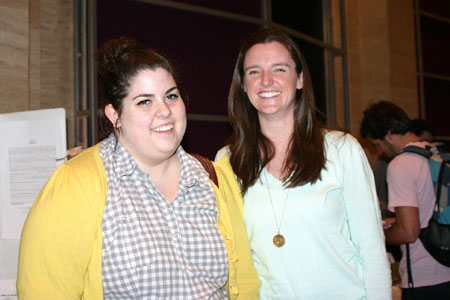
WLP Lecturer Molly McGillicuddy’s course, Exploring Identity Through Genre, instructed the students on how to talk about research, starting with a question and pushing it forward, doing research, and asking more questions. She said she also wanted to take research from the conventional in-the-library type of work to interviews, field research, and broadening the scope of research. “The students were exposed to different genres across the semester. They did presentations on comic books, musicals, and film. They also got to choose any genre that they wanted and translate their memoir into a genre of their choice. The final project was an anthology of all of the memoirs.”
Rose Perry ’14 was enrolled in McGillicuddy’s class and was eager to share and discuss her work at the showcase. “The most recent thing we wrote was a memoir,” she said. “It was a great experience, because we all got to work together as writers through the workshop process. We also worked on a Facebook profile project, which was where we chose a public figure, like a celebrity or someone historical, and made a Facebook profile about them based on the research that we did. We did a rhetorical analysis essay, and wrote about the different ways that people wrote about Hurricane Katrina, be it through hip-hop or news reports. I wrote about emails.”
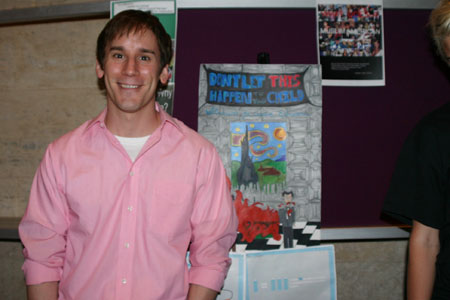
WLP Lecturer Ben Lobpries taught The Fear Factor, which analyzed the function of fear in people’s lives. “We started with personal experiences of fear and then moved into fear on a broader spectrum. The research papers were on campaigns of fear. And for their final projects, they created their own campaigns and made the decision whether or not to use fear tactics or create campaigns of appeals.” As with all of the research classes, the students that took The Fear Factor conducted research, wrote a research report, and created a final project – which for them was the production of original propaganda material, like an anti-war poster.
One group of first-year students called themselves PAO, or People Against Overmedication. Their basic goal was to raise awareness about overmedication in America. PAO created three genre pieces, one of which featured a pill-studded, coffin-like sculpture. Created by Shelby Sims ’14, the sculpture was as an indicator of the correlation between overmedication and death. Another product was a public service announcement created by Mackenzie Winslow ’13 that reflected on the powerful influence of television advertisements made by the pharmaceutical industry. The final product was a poster with the group’s slogan “Think before you swallow,” which was designed by Marian Pritchard ’14.
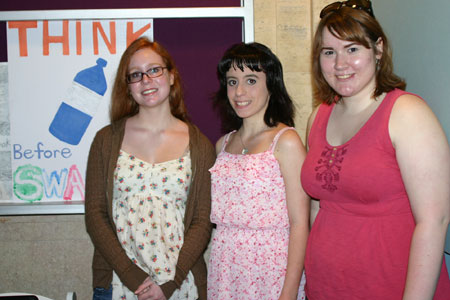
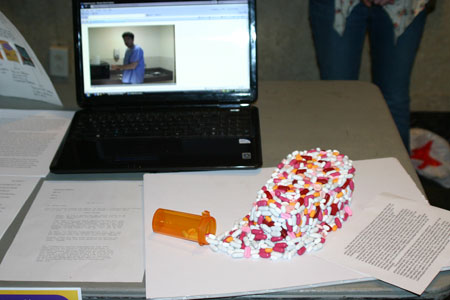
“We did research not only on the topics, but also about the mediums that we used to present our information,” Pritchard said about her experience in the course. “For example, I researched different kinds of posters, how to come up with different things to include in my poster, and how to present that information in a way that would really grab people’s attention.”
“Our class gave us the resources and tools to pursue the topic and develop our projects,” Winslow said. “We really worked hard to inform people about the danger that mixing a certain prescription with another one can cause. It’s apparent in some of the celebrity deaths that we have seen in the last few years, specifically Heath Ledger.”
One new addition to the First-Year Writing Program was a yearlong course called Bilingual Research. Taught by Marko, students had to apply to take this class the summer before their enrollment at Emerson. “We sent out 80 invitations and within three days received more than 50 applications from incoming students from all over the world,” Marko explained.
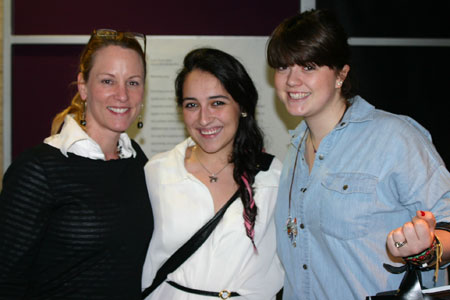
Half of the students in the class were Spanish speakers and the other half spoke little to no Spanish, Marko said. Students did not have to know how to speak Spanish in order to take the class. “The idea is negotiating Spanish as a rhetorical situation, and also to realize that when you chop off Spanish and don’t allow it in the room, you prevent people from bringing in the identities that they already have.”
Two of the students in this course read their work during the second half of the FYWP showcase. Laura Zea ’14 read from Rosita, a children’s story about a girl named Rosita who lives in the border town of Tijuana, Mexico. Each day she has to pass through immigration on her way to school. The guards rummage through her belongings, often confiscating portions of her lunch.
The final product of the Bilingual Research class was an anthology called Cuzando Borderlands, which was published through a seed grant from Emerson’s Office of Service Learning and Community Action. The class also produced a video. View the Bilingual Research Writing Class video»
Categories